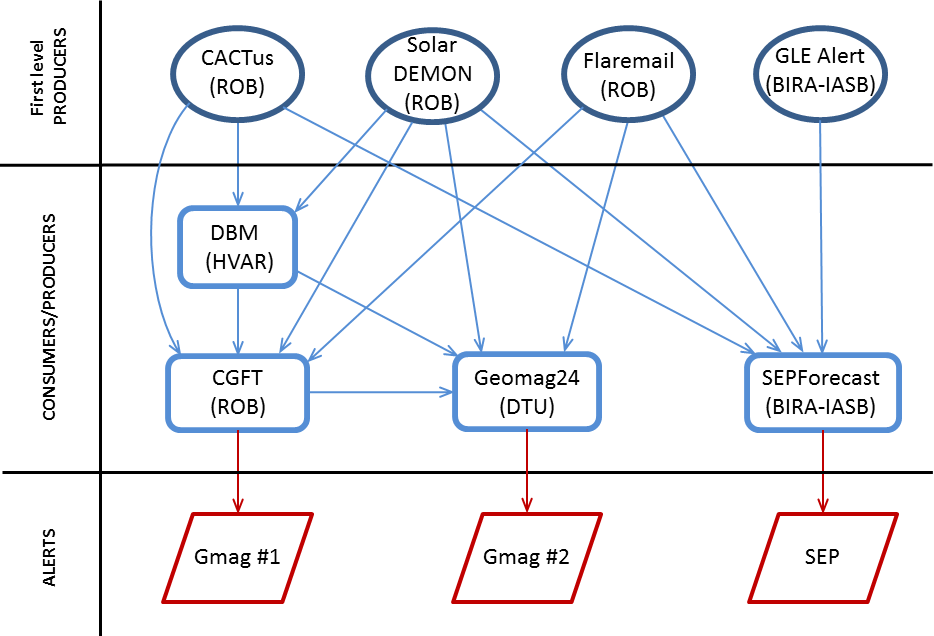
Flow diagram of the tools used in the COMESEP alert system.
First level producers
CACTus: CACTus stands for “Computer Aided CME Tracking”. It detects autonomously CMEs in image sequences from SOHO/LASCO and STEREO/COR2. For the COMESEP alert system, only the LASCO detections will be used. Whenever a CME with angular width larger than 150 degrees is detected, an alert is sent to the COMESEP system.
Solar DEMON: The Solar Dimming and EUV wave Monitor Solar (DEMON) is capable of providing information on flares (location, time and relative intensity), automatically and in real time using SDO/AIA data.
Flaremail: Whenever an M- or X-class flare is detected in the GOES X-ray data, an alert is sent to the COMESEP system. This service is provided in near real-time.
GLE alert: The Ground Level Enhancement (GLE) tool parses the GLE Alert Plus produced by the University of Athens and ISNet (http://cosray.phys.uoa.gr/index.php/glealertplus) to the COMESEP alert system. GLE Alert Monitor polls the history page every 2 minutes and checks if there is a new GLE alert. If so, it parses the information and sends an alert to the COMESEP alert system.
Consumers/Producers
DBM:This tool provides as output the ICME Sun-Earth transit time, the arrival time, and the impact speed for the ICME segment which is expected to hit the Earth. It requires as input: CME take-off date; CME take-off time (the time when its frontal edge reached the distance of 20 solar radii, R0=20); CME speed at R0=20; asymptotic solar wind speed; central meridian distance of the CME source region; true angular width of the CME. If some of the last three input parameters are missing DBM automatically applies a “lower-level” DBM option.
CGFT: The CME Geomagnetic Forecast Tool (CGFT) provides a probability estimation of arrival and likely geo-effectiveness of a CME based on its solar parameters, as well as an estimate of the storm duration. The probability of CME arrival is estimated on the source position of the associated flare, while the geo-effectiveness is estimated based on the CME width and speed, source position and X-ray class of the associated flare. The geo-effectiveness is defined based on the Dst index (disturbance storm time). The combination of probability estimations of arrival and geo-effectiveness for a CME defines the risk level. In addition, the estimated storm duration is based on the estimated geo-effectiveness and the month of the eruption.
SEPForecast: This tool predicts the probability and level for a radiation storm with proton energies > 10 MeV and > 60 MeV resulting from a flare (M class or larger issued by Flaremail). The following information from other alert tools are also included if available: the flare location from Solar DEMON, the CME speed and width from CACTus, and when a GLE is observed from GLE Alert Monitor. Subsequent updates of the alert will be issued if this information becomes available after the SEP Forecast alert has been issued. The predictions are based on a statistical analysis of SEP events observed during solar cycle 23. When the flare intensity and location is received within the COMESEP Alert System, SEPForecast produces predicted time profiles of SEP intensity at 1 AU from the Sun, by consulting a previously generated database of test particle model simulation outputs. Flux profiles of energetic protons for the integrated E>10 MeV and E>60 MeV energy ranges are calculated at the Earth’s location . Parameters of the proton intensity profiles such as the time to maximum intensity, event start and end times based on the above flux thresholds of 10 and 7.9 10-2 pfu, are derived from the predicted profiles.
Geomag24: Estimates of the risk level of geomagnetic storm occurrence for the next 24 hours is provided by Geomag24. This tool takes as input recent alerts issued by the DBM and CGFT of ICME arrival time, speed and estimated geoeffectiveness. Observations of the last months of geomagnetic activity and solar wind observations combined with estimations of the background solar wind speed/coronal hole area is used to include the risk of corotating interation region generated magnetic storms in the estimate. This is combined with in situ solar wind and geomagnetic data to estimate the risk of geomagnetic storm for the next 24 hours. The first part of the program is dedicated to linking DBM/CGFT alerts and forecasted high-speed streams to observed in-situ data. The second part evaluates storm level and probability.
Alerts
Gmag Alert #1: Triggered when a CME is estimated to be geoeffective. The process is started by a CME alert from CACTus, then the DBM will calculate the arrival time of the CME to the Earth (using also as input information on the background solar wind speed). The CGFT will estimate the risk of a geomagnetic storm, by combining the CME information with the corresponding flare data from Flaremail (flare intensity) and Solar DEMON (flare position).
Gmag Alert #2: Provides the geomagnetic storm risk for the next 24h. Therefore, this alert provides information on the coming hours, whereas Gmag Alert #1 deals with a CME that may arrive several days after the alert was issued (depending on CME speed).
SEP Alert: Issued by the SEPForecast tool for every flare with a magnitude of at least M1. The probability of occurrence and the expected strength of radiation storms with proton energies > 10 MeV and > 60 MeV are evaluated based on input from Flaremail, Solar DEMON, CACTus and GLE Alert. The expected flux profiles from the test particle model simulation are also included.

